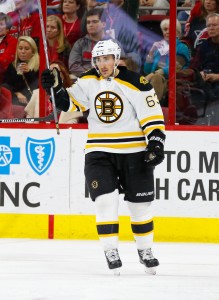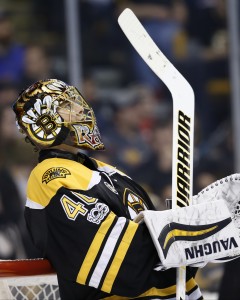With the trade deadline fast approaching, we will be taking a closer look at the situation for each team. Where do they stand, what do they need to do, and what assets do they have to fill those needs?
Outside of the Vegas Golden Knights, there may be no bigger surprise in the NHL this season than the Boston Bruins. Following a 6-7-4 start, capped off by a four-game winless streak in mid-November, the Bruins have won 26 of their last 34 games, have the fewest regulation losses in the league, and trail only Vegas and the Tampa Bay Lightning for the best points percentage in the NHL. With games in hand on both clubs, the Bruins have gone from a team that many felt pre-season would miss the playoffs to one with a legitimate shot at the President’s Trophy. Boston is bona fide contender and thus a surefire buyer. The only question that remains is to what extent they are willing to trade futures for immediate help. The evidence points to a quieter deadline in Boston than some may expect.
Record
31-11-8, 2nd in the Atlantic Division
Deadline Status
Buyer
Deadline Cap Space
$2,452,057 in deadline cap space
43/50 contracts per CapFriendly
Draft Picks
2018: BOS 1st, BOS 2nd, BOS 3rd, BOS 4th, BOS 6th, BOS 7th
2019: BOS 1st, BOS 2nd, BOS 3rd, BOS 4th, BOS 5th, BOS 6th, BOS 7th
Trade Chips
Bruins GM Don Sweeney has been clear that he won’t trade any of the team’s young players on the roster. While that surely includes Charlie McAvoy – one of the most untouchable players in the NHL right now – Brandon Carlo, Matt Grzelcyk, Danton Heinen, Jake DeBrusk, and Anders Bjork, where exactly Sweeney draws the line could determine the size of the deals he’s willing to make. Could frequent 13th man Frank Vatrano be on the move? An electric player in the AHL, Vatrano has failed to show he can produce at the same level in the NHL. A chance of scenery and a larger role on a young, struggling squad could be what Vatrano needs to rediscover his scoring touch, potentially making him an enticing asset. Would Sweeney be willing to move his AHL “tweeners” like Austin Czarnik or Rob O’Gara, who have shown big-league ability, but haven’t been able to crack the roster in Boston? Sweeney may also be reluctant to move many of the Bruins younger prospects, like recent first- and second-rounders Zach Senyshyn, Jakob Forsbacka Karlsson, Jakub Zboril, and Jeremy Lauzon in Providence and Trent Frederic, Ryan Donato, and Ryan Lindgren in the NCAA, especially with several ready to fight for a spot in Boston as early as next year. The Bruins own all but one of their picks over the next two years and that wealth could ultimately wind up being the team’s real trade chip.
Players To Watch
LW Frank Vatrano, C Austin Czarnik, LW Peter Cehlarik, D Rob O’Gara, D Emil Johansson
Team Needs
1) Forward Depth
If you can’t tell from the list of players above, it seems like the Bruins are not exactly aiming to acquire the best that the trade market has to offer. The team is unwilling to move young roster players and has high hopes for their many promising prospects. Sweeney and company have done an excellent job of drafting and developing and seem more inclined to wait and see who pans out and who doesn’t rather than trade them away for rentals. The Bruins’ farm system is also severely lacking in right-shot defensemen and right wingers, meaning they’d likely prefer to hold on to their top picks if possible in search of a solution to those holes. The result is a lineup of middling or aging prospects and mid- and late-round picks as the B’s preferred trade capital, not enough to acquire stars, but sufficient to add depth players. And for the 2017-18 Bruins, that’s perfectly fine. They showed early on this season that they have the depth already to deal with injuries up front (and on the blue line) and since the team got healthy, they’ve been rolling on all cylinders. Each scoring line has two veterans and a young player, led by arguably the league’s best grouping of Brad Marchand, Patrice Bergeron, and David Pastrnak. A second line that has seen success turning a left-handed natural center in Ryan Spooner into a right wing with David Krejci and DeBrusk and a third line with immense chemistry in David Backes, Riley Nash, and Heinen round out a solid top nine. Perhaps the one area where they could use some assistance is on the fourth line, where Tim Schaller, Noel Acciari, and rookie Sean Kuraly have done a fine job, but the addition of a solid, two-way bottom-six forward (or two) could be a welcome addition to the energy line and another injury depth option. Even if the Bruins don’t see a need for a starter, with late draft picks to burn, they could add another veteran forward just to improve their depth. In a buyer’s market, even one of the bigger names on the market could fit this role.
2) Left-shot depth defenseman
Similarly, each defensive pair is also well-balanced with a veteran and a youngster and a puck-mover with a physical threat. The Bruins usually line up with Zdeno Chara and Calder candidate McAvoy, Torey Krug with Carlo, and possession monster Grzelcyk with Kevan Miller. Now that he’s healthy, career-starter Adam McQuaid is the #7 defenseman in Boston – stellar depth already – and free agent addition Paul Postma is #8 – also impressive. The only problem is that both McQuaid and Postma are right-handed, as are the right-side rearguards on each pair. If injury strikes the left side, or if Grzelcyk’s play drops off, the B’s could use a left-shot option. O’Gara and Tommy Cross have seen NHL action and Zboril, Lauzon, and Johansson have shown NHL promise, but the Bruins can afford to add a more reliable player with regular play time this season if they so choose.
3) Top-six right wing with term
Don’t expect this. Long-term, there could be a hole on Krejci’s right side, as Backes did not work out last season and Spooner’s success thus far has come as a surprise. Senyshyn or Donato and an off-wing option like Bjork or Cehlarik could eventually take the job, but there are some who think the Bruins should instead try to buy one of the top wings on the trade market. However, there are two problems with this thought: 1) Sweeney seems unwilling to part with the pieces necessary to land such a player, and 2) the line chemistry implications could backfire. Spooner is an offense-first, top-nine player. If forced out of his current spot, Spooner’s only real option would be to supplant Nash on the third line. If that doesn’t work out, then there’s no role for him. An expensive trade could wind up pushing one of the Bruins’ top play-making forwards out of the lineup. Adding a top-six winger would be a luxury for Boston and Sweeney does not seem to be a guy keen on giving up hard-earned, home-grown prospects or picks for a luxury.

